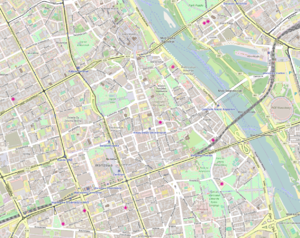Museum of John Paul II Collection
The Museum of John Paul II Collection (Polish: Muzeum Kolekcji im. Jana Pawła II) in Warsaw, also known as the Porczyński Gallery or Carroll-Porczyński Collection, is a museum dedicated to its painting collection, which is housed in the building of the former stock exchange and Bank of Poland.[1] The collection includes around 400 exhibits, mainly Old Masters and the Impressionists, along with some copies of masterpieces of European painting.[2]
 Building of the former stock exchange | |
| Established | 1989 |
|---|---|
| Location | 1 Bank Square Warsaw, Poland |
| Public transit access | |
| Website | mkjp2.pl |
History
editZbigniew and Janina Porczyński have been amassing the collection since 1981. In the first three years, the couple concentrated on adding paintings with biblical themes but later portraits and impressionistic works were added. In 1986 the couple transferred about 400 exhibits to the Archdiocese of Warsaw and the Polish nation and created a foundation to supervise the collection.[3] The first part of the collection was displayed publicly on 5 November 1987 at the Museum of the Warsaw archdiocese (Muzeum Archidiecezji Warszawskiej) at Solec Street.[4] The second part was displayed from 14 September to 30 December 1988.[4]
In 1989 the beneficiaries of the foundation, the Primate of Poland and the Polish Arts and Culture Ministry, decided to create a museum to provide a permanent display of the collection.[5] The city of Warsaw provided the collection with a permanent home in a building designed by Antonio Corazzi in 1825[1] - the former stock exchange rebuilt after the Second World War destruction.
Criticism
editSince 1987 various art experts put in doubt the authenticity of many important works in the collection.[2] The Polish art historians Mieczysław Morka[4] and Waldemar Łysiak contributed several times to this criticism.[6] A painting signed by Alfred Sisley (River landscape) is a forgery by Tom Keating.[7]
Apart from forgery allegations and unclear financing of the foundation by the public sector, some other activities of the foundation were criticized (the organization of commercial events in the museum premises).[5]
Collection
editThe collection is displayed in eight rooms and arranged thematically: Impressionists, mythology and allegory, portraits and self-portraits (in the two-story hall "Rotunda"), mothers and children, effigies of the Madonna and Child, biblical themes, still lifes and landscapes (in the gallery)[2] and a room dedicated to the monumental painting Baptism of Lithuania (1889) by Wojciech Gerson.[1]
The majority of the collection consists of works by British, Dutch, Early Netherlandish, Flemish, French, German, Italian, Spanish and Swiss Old Masters, their pupils and followers. Among the artists represented are Paris Bordone, Cornelis van Haarlem, José de Ribera, William-Adolphe Bouguereau, Pierre-Auguste Renoir, Vincent van Gogh and a significant collection of paintings by Swiss painter Fritz Zuber-Bühler.
Sculpture is represented with bronze casts of Jupiter and the eagle by Julien Dillens, the Head of Saint John the Baptist by Auguste Rodin and the Unicorn by Salvador Dalí.[8]
-
Cauliflower and Pomegranates (c. 1890), Pierre-Auguste Renoir[9]
-
Virgin and Child with Saint Anne, Albrecht Dürer
-
Virgin and Child, Jacopo Pontormo
-
Daphnis and Chloe, Paris Bordone
-
Nailing to the Cross, Cornelis van Haarlem
-
Portrait of Mother and Daughter, Cornelis de Vos
-
A Philosopher, José de Ribera
-
Donkeys in the Stable, John Constable
-
Egyptian Water Carrier, Jean-Léon Gérôme
-
Venus and Cupid, William-Adolphe Bouguereau
-
Portrait of a Young Girl in Pink Dress, Raimundo de Madrazo y Garreta
See also
editReferences
edit- ^ a b c Neal Bedford (2008). Poland. Lonely Planet. p. 94. ISBN 978-1-74104-479-9.
- ^ a b c Mark Salter; Jonathan Bousfield (2002). Poland. Rough Guides. pp. 105–106. ISBN 1-85828-849-5.
- ^ "History". www.muzeummalarstwa.pl. Retrieved 23 January 2013.
In 1986, Janina and Zbigniew Carroll-Porczynski donated a rich collection of Western European art, amounting to almost 400 paintings and sculptures which had been assembled over many years, to the Church and the Nation. (...) From its very beginning until the present time, the Museum was and is maintained from funds donated to Fundacja Arteks.
- ^ a b c Mieczysław Morka (1999). Kolekcja im. Jana Pawła II, Kompromitacja kościoła i państwa. Agencja Wydawnicza Il Libro. pp. 105–106. ISBN 83-87761-17-6. Archived from the original on 2016-03-04. Retrieved 2013-01-23.
- ^ a b Bronisław Tumiłowicz (22 January 2006). "Sztuka i bezprawie". Przegląd 35/2003. Retrieved 23 January 2013.
- ^ Waldemar Łysiak (2004). Rzeczpospolita klamcow Salon. Wydawnictwo Nobilis. p. 324. ISBN 83-917612-5-8.
- ^ Łukasz Radwan (22 January 2006). "Pralnia płócien". Wprost 3/2006 (1206). Retrieved 23 January 2013.
W Muzeum Kolekcji im. Jana Pawła II (Fundacja Janiny i Zbigniewa Porczyńskich) znajduje się np. falsyfikat "Pejzażu rzecznego" Toma Keatinga, który muzeum eksponowało jako arcydzieło Alfreda Sisleya. Tyle że wcześniej Keating na oczach widzów w programie telewizyjnym przyznał się do fałszerstwa.
- ^ "Museum of John Paul II Collection (Muzeum Kolekcji im. Jana Pawła II)". www.inyourpocket.com. Retrieved 12 November 2017.
Their collection is now housed in the historical Bank of Poland building and includes a unicorn sculpture by Salvador Dali, a painting of Renoir's son Pierre, an idyllic farm scene by Van Gogh, the head of John the Baptist by Rodin.
- ^ One of the most valuable and undisputed paintings in the collection, originally in the collection of Galerie Nichido in Tokyo. Janusz Miliszkiewicz; Mieczysław Morka; Andrzej Borkowski (1993). Kolekcja Porczyńskich-genialne oszustwo?. Polska Oficyna Wydawnicza "BGW". p. 244. ISBN 83-7066-548-9.
External links
editMedia related to Porczyński Gallery at Wikimedia Commons
